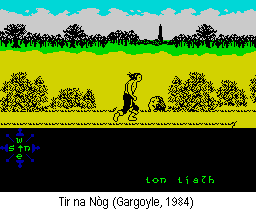|

By Lloyd Mangram
December
1984
Issue 11
|
|
There
were moments when people glibly assumed Oliver Frey
loathed Spectrums owing to the number he destroyed in
CRASH cover illustrations, but the opposite was the
truth. As he remarked when ZZAP! came along, the old
Spectrum was one of the friendliest objects which simply
lent itself to painting, unlike the brown Commodore
64 which merely resembled a piece of fudge. Here's another
cover unrelated to any game, excepting perhaps Mizar's
Out Of The Shadows, and one that was actually
a reworking of an old mail order catalogue cover, featuring
a hero bursting forth from a TV screen.
|
The promise Realtime had shown in 3-D Tank Duel was
well and truly realised in their second release, Starstrike,
which recreated all the thrills of the popular coin-op Star
Wars. It was in a bit of a race with Design Design's Dark
Star, a similar game in principle. But both Smashes showed
how a closely related concept can be very differently implemented.
In their own ways, they were state-of-the-art software.
 Equally
excellent and very different from either 'Star' game and from
each other were the Smashes Tir Na Nòg and Skool
Daze. Gargoyle Games gave us Cuchulainn, Sidhe and Greg
Follis's Grego-Celtic mythology, giant animated characters,
mental 3-D and a game hard to distinguish between pure adventure
and arcade/explorer. Microsphere's characters were smaller,
but beautifully animated against authentic school backgrounds,
providing another sort of adventure game but with properly
crude schoolboy humour as its theme. These two were also state-of-the-art.
Bug-Byte's Turmoil and Melbourne's Sir Lancelot
were not, but were still highly playable and addictive games
of sufficient quality to make them stand out from the rest
of the crowd. Equally
excellent and very different from either 'Star' game and from
each other were the Smashes Tir Na Nòg and Skool
Daze. Gargoyle Games gave us Cuchulainn, Sidhe and Greg
Follis's Grego-Celtic mythology, giant animated characters,
mental 3-D and a game hard to distinguish between pure adventure
and arcade/explorer. Microsphere's characters were smaller,
but beautifully animated against authentic school backgrounds,
providing another sort of adventure game but with properly
crude schoolboy humour as its theme. These two were also state-of-the-art.
Bug-Byte's Turmoil and Melbourne's Sir Lancelot
were not, but were still highly playable and addictive games
of sufficient quality to make them stand out from the rest
of the crowd.
Deep down in the Adventure Trail (or rather up in Newcastle-upon-Tyne
where he lives) Derek was telling everyone who had packed
away their Spectrums to get them out and fill the boxes with
straw and tortoises, for 'when it comes to Spectrum software,
you've never had it so good.' He was excited by Level 9's
Return To Eden, Bug-Byte's Twin Kingdom Valley,
Games Workshop's Tower Of Despair and the ebulliently,
wickedly funny Valkyrie 17 from the anarchic Ram Jam
Corporation (through Palace Software).
To cap it off Out Of The Shadows from unknown Mizar
was a Smash, and thereby hangs a tale - and a CRASH failure.
If anyone at CRASH felt unhappy about the reliance distributors
and retailers were putting on CRASH reviews for stocking,
then they were probably equally happy at being able to employ
this unasked for power on the behalf of new or very small
software houses. Some were finding it harder to get a look
in with the increasingly professional and hard-nosed market
place. Our record in their favour had been encouraging. But
with Mizar, we drew a blank. No distributor would accept the
game, having failed to spot its marketability, despite its
CRASH Smash status. It was galling. And it showed more clearly
than ever that the world was changing with blinding speed.
At the beginning of 1984, an advertisement helped sales, by
the end of the year even a full-scale marketing campaign was
capable of failing to attract the distributors' attention.
For the small independent software house, it looked like the
beginning of the end.
Up until this time much of CRASH editorial was written without
travelling the country visiting software houses, most being
done over the phone. More recently we had been happy to see
how many people would actually trek up to Ludlow to visit
us, a mark indeed of acceptance. But two pleasant occasions
forced first Roger and Oliver to visit London, and then Matthew
and Roger. The first was a trip to see a preview of the film
The Last Starfighter (about which Roger wrote an article
on its use of computer graphics), and the second was to see
a preview of Ghostbusters, set to be the first real
big film tie-in. But for the game from conquering American
company Activision we had to wait . . .
|